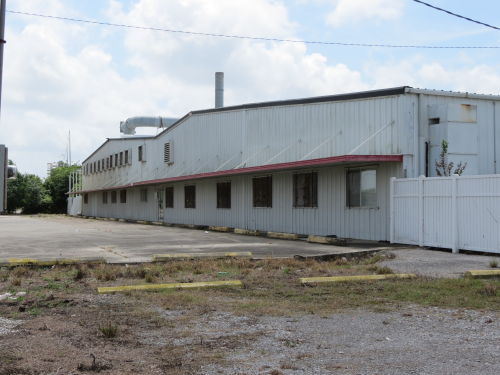‘Cinderella’ Vandebilt bounced in Class 4A Quarterfinals
May 13, 2014
Capital One, JA foster financial responsibility
May 13, 2014The Environmental Protection Agency proposed the former site of Delta Shipyards in east Houma to its National Priorities List of Superfund Sites after discovering oily waste stored in evaporation ponds for more than 20 years.
The hazardous materials were found in ground water, surface water and soil surrounding the 165-acre site at 200 Dean Court in east Houma.
If not remediated, the waste has the potential to spread further into wetland areas and nearby waterways, posing a risk to human health and the environment, officials said.
Greg Langley, press secretary for the Louisiana Department of Environmental Quality, said the state has known about contamination at the site for several years. In 2012 a request was made to the EPA in order to get more funding to help clean up the heavy metals, which tend to be more expensive to remediate.
Some of the contaminants found at the site include arsenic, barium, benzene, chromium, lead and mercury.
Langley said most of the waste has “evaporated over time and dispersed into the atmosphere.”
“The atmosphere has diluted them to the point where it’s not a factor,” he said of some of the waste. “Because it’s so old it’s pretty much stable at this point.”
Brenda Cook, NPL coordinator with the EPA, said the contamination in 2012 was 10 to 12 feet deep in and around several unlined evaporation ponds that Delta Shipyard used to dispose of oilfield drilling material.
“We found contamination at depth and we found contamination in the wetland area and within the company canal,” Cook said. “They’ve been there since the facility went inactive.”
In the 1960s, Delta Shipyard operated as a cleaning and repair facility for small cargo boats, fishing boats and oil barges.
Al Levron, Terrebonne Parish manager, said Delta Shipyards was a “very big, active iron works facility that did anything related to the oil field.”
He said the shipyard’s ability to have unlined evaporation ponds was “the nature of the business at the time.”
“The environmental laws in Louisiana were not very strong prior to the 1980s,” Levron said. “They were relatively weak as it relates to solid waste and oilfield waste.”
As the oil field economy started to suffer in the 1980s, the industries in Terrebonne Parish also experienced a rapid decline.
“The economy in Terrebonne Parish collapsed in the early 1980s because oil prices went down,” Levron said. “As a result, the Delta Shipyards facility went bankrupt.”
He estimated the property sat idle from about 1981 to 1990 when former State Senator Lynn Dean from St. Bernard Parish acquired the property and subdivided it for several businesses to utilize the land.
Throughout the years, sections of the property shifted owners with several industry-based businesses taking over such as Chromalloy and GEMOCO, both also defunct residents of the site.
Langley said part of the investigation hosted by the EPA would attempt to identify a responsible party for the hazardous materials.
“I don’t know if they will be able to do that or not but that will be a part of the research they are doing,” he said. “If they do (identify), some of the cost will be shifted to them.”
Cook said since the site has been proposed to the federal register, the next phase of the process will be a 60-day public comment period, followed by a study to learn the extent of contamination and develop remedies to address the clean up. The risk assessment will consider the level of contaminants on site and its relationship to the population.
“The process can generally take several years,” Cook said. “Five years is not uncommon. Some sites with groundwater problems take 15 to 20 years.”
In the meantime, the Louisiana DEQ will continue to work closely with the EPA to monitor the site and the risks of contamination.
Langley said the only threat would be a “huge storm” since it would move the contaminants in the pits to surrounding areas.
“There is really no danger unless there is immense flooding,” Langley said. “If there was some type of threat or emergency, we would respond.”
The EPA’s proposal sheet indicates the closest residential property about 400 feet west of the open pits.
“At this time the waste is well contained and there is not a lot of direct access to these pits,” Cook said. “I would not anticipate any immediate risk because people are not in direct contact with them.”
Local, state and national officials agree the announcement is positive news since it will help to generate funding and determine the most efficient method to clean up the site.
“This is a positive thing,” Cook said. “Because the site is proposed to the NPL, we will be able to do a cleanup and future contamination would be mitigated.”
Laws concerning chemical waste dumps were relaxed throughout much of the nation until the EPA added the Love Canal site in the City of Niagara Falls, New York to its National Priorities List in September 1983.
In the 1940s, the property was occupied by Hooker Electrochemical, which disposed more than 21,000 tons of chemical wastes, including pesticides and dioxin. In 1953, the landfill was covered and the area experienced extensive development including an elementary school and many homes.
As time progressed, contaminated ground water rose to the surface and more than 950 families were evacuated through the 1970s and ‘80s. Several residents of Love Canal died from contaminants and many survivors continue to report health complications years after the incident.
The Love Canal site helped develop Superfund legislation, which allows the EPA to clean up hazardous waste sites, such as Delta Shipyards in Houma, and investigate responsible parties for the pollution.
The former building of Weatherford GEMOCO sits vacant on Industrial Boulevard near Dean Court in east Houma. Many of the buildings surrounding Dean Court exemplify the once bustling gas and economy that stemmed from the property. Delta Shipyards used the location in the 1960s to repair cargo boats and oil barges, which caused the EPA to propose the site to their National Priorities List as a Superfund site.












